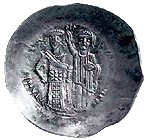 |
|
 |
The fall of the Empire of Thessalonike
 he Empire of Thessalonike, reduced in size after
Theodore Doukas'
defeat at Klokotnica in 1230, passed into the hands of his brother,
Manuel.
Manuel sought an alliance
he Empire of Thessalonike, reduced in size after
Theodore Doukas'
defeat at Klokotnica in 1230, passed into the hands of his brother,
Manuel.
Manuel sought an alliance
 with the Emperor of Nicaea, and to this end, in 1233, he resumed his relations with the Patriarchate of that state, which had been severed following Theodore Doukas' coronation as Emperor. A few years later, in 1242,
John Vatatzes forced
John Doukas, the
successor of Manuel (1237-44), to give up his imperial title and to recognise the Emperor of Nicaea as his suzerain. Doukas had to be content with the title of
despotes.
The
Mongol
incursion into Asia Minor,
with the Emperor of Nicaea, and to this end, in 1233, he resumed his relations with the Patriarchate of that state, which had been severed following Theodore Doukas' coronation as Emperor. A few years later, in 1242,
John Vatatzes forced
John Doukas, the
successor of Manuel (1237-44), to give up his imperial title and to recognise the Emperor of Nicaea as his suzerain. Doukas had to be content with the title of
despotes.
The
Mongol
incursion into Asia Minor,
 which worried Vatatzes, somewhat delayed the final recovery of Thessalonike by the Nicaean forces. However, the Mongol raid left the Empire of Nicaea intact, while ridding it, at the same time, of its Turkish rival, who, in 1243, was forced to pay tribute to the Mongols. It also considerably weakened the
state of Bulgaria.
Vatatzes now intervened once again in the Balkans and, taking advantage of the death of the Bulgarian tsar, Koliman (1241-46), he extended his dominion over Thrace, as far as the source of the river Hebros, and also over Macedonia, as far as the Axios river. Finally, responding to the call for support by those who were dissatisfied with the despotes Demetrios (1244-46), the successor of
John Angelos,
he turned against Thessalonike, which he conquered in 1246.
which worried Vatatzes, somewhat delayed the final recovery of Thessalonike by the Nicaean forces. However, the Mongol raid left the Empire of Nicaea intact, while ridding it, at the same time, of its Turkish rival, who, in 1243, was forced to pay tribute to the Mongols. It also considerably weakened the
state of Bulgaria.
Vatatzes now intervened once again in the Balkans and, taking advantage of the death of the Bulgarian tsar, Koliman (1241-46), he extended his dominion over Thrace, as far as the source of the river Hebros, and also over Macedonia, as far as the Axios river. Finally, responding to the call for support by those who were dissatisfied with the despotes Demetrios (1244-46), the successor of
John Angelos,
he turned against Thessalonike, which he conquered in 1246.
|